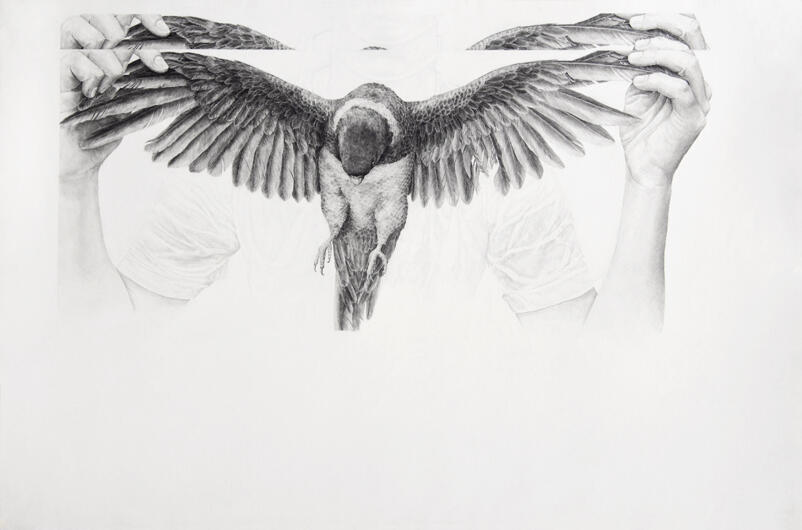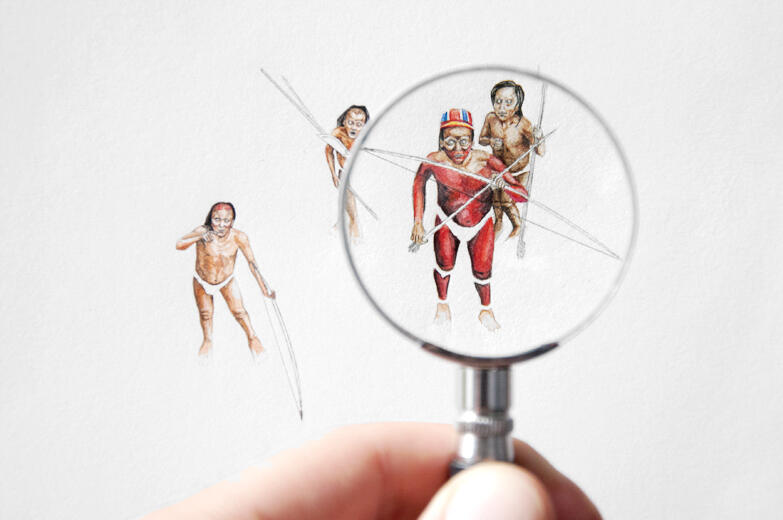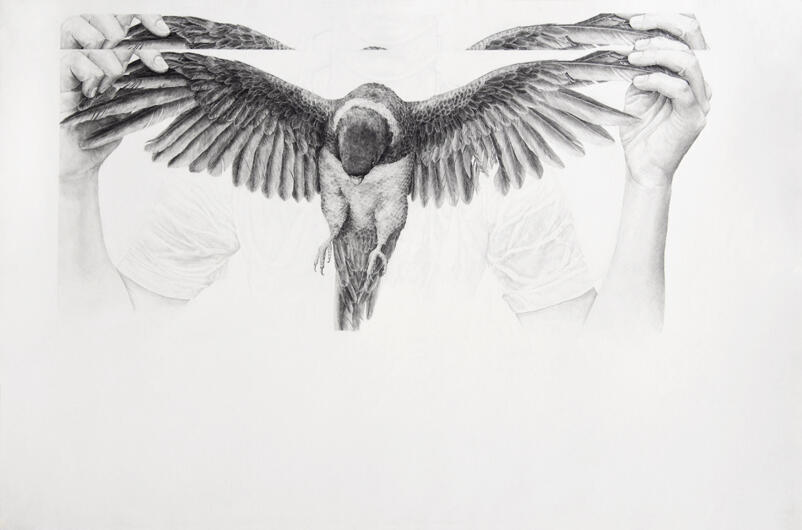Daniel Otero Torres
Marine Veilleux, Paris
At first glance, the pencil drawings by Daniel Otero Torres (Bogotá, 1985) elicit joy and fill the viewer with wonder.

Extremely precise, finely drawn and imbued with a surprising realism, they quickly invite us to enter their world. This body of drawings on paper and cutout metal makes up the Colombian artist’s first solo show at galería Marine Veilleux, a few steps away from the famous Pompidou Museum of Modern Art.
The Encounter (watercolor and pencil on paper, 2012) between the white Europeans and the red-skinned or dark-skinned indigenous peoples ironically replaces the traditional “discovery”. A series of miniature indigenous people painted in color appear after we have glanced over an immaculately white paper surface. How can one see them without the help of a magnifying glass? Come closer! More, a little more and you will see something.
They are beautiful and precious, treated as jewels despite their being “savages”. They might be included in a cabinet of curiosities. They are indigenous people belonging to isolated Amazon tribes that the artist gleaned from press photographs. They were discovered by Brazilian helicopters along the border between Brazil and Peru in 2009. We ignore their name and their language. Their bodies are painted; they wear loincloths and carry spears, bows and arrows. They are aiming their weapons at us, they are staring at us. We are looking at one other.
Without being anywhere, they and the paper are there. What is the border between these individuals and us, except the difference in scale? Space-time references are not important; what matters here –the artist tells us – is the moment of the encounter. The exchange of gazes says a lot about the relationship with the other; the domination relationship.
This reflection continues in the basement with a pencil-drawn metal sculpture featuring a native who is filming us. Here the situation is reversed: the observer becomes the observed.
In front of the Encounter series, a man carrying boxes, packages bags, a man sitting on a chair and a horse moves forward – motionless –: Untitled (Bearer), pencil on paper, 2013.
He looks like an Equeco. Except that the Andean god of abundance is not the bearer but an explorer-colonizer. Young and vigorous, he allows himself to be carried – along what paths? – on the back of a man of whom we barely glimpse his chin. He sinks under the weight he is carrying. This chimerical package is crossing the whole width of the white paper. There are no spatial references here, either. Reflection, alone, focuses on a certain pattern of human relationship that is absurd.
Drawing after drawing, a sarcastic irony is unveiled. The mayor of Toronto, Rob Ford, has freed himself from the paper ( Ford, pencil on metal, mixed media, 2014). His belly has .gained volume in a convex metal sheet. His apathetic laughter bursts eardrums. So much absurdity in an upside-down world: he is an anti-hero.
In Otero’s world, exotic animals such as parrots or toucans, are pets, removed from their natural habitats. We don’t know if they are dead or asleep. Only the dog is alive, and in spite of the fact that it has just ferociously destroyed an armchair, it provokes us with a mocking gaze. In these images, the birds are held by human beings, amputated executioners – defined by the eraser.
Alluring, the decadence pointed to by Otero dresses in full regalia.
-
 2012 Watercolor and pencil on paper - 29.7 x 42 cm - Detail viewed through a magnifying glass - Credits: Daniel Otero Torres
2012 Watercolor and pencil on paper - 29.7 x 42 cm - Detail viewed through a magnifying glass - Credits: Daniel Otero Torres
Acuarela y lapiz sobre papel - 29,7 x 42 cm - Detalle visto con lupa -
2014 - Pencil on metal, mixed technique - 20 x 22 x 119 cm - Credits: Daniel Otero Torres
Lapiz sobre metal, técnicas mixtas - 20 x 22 x 119 cm -
 2014 - Pencil on paper - 120 x 80 cm - Credits: Daniel Otero Torres
2014 - Pencil on paper - 120 x 80 cm - Credits: Daniel Otero Torres
Lapiz sobre papel - 120 x 80 cm




